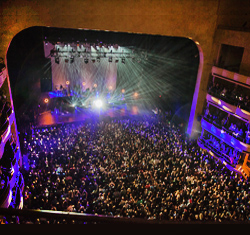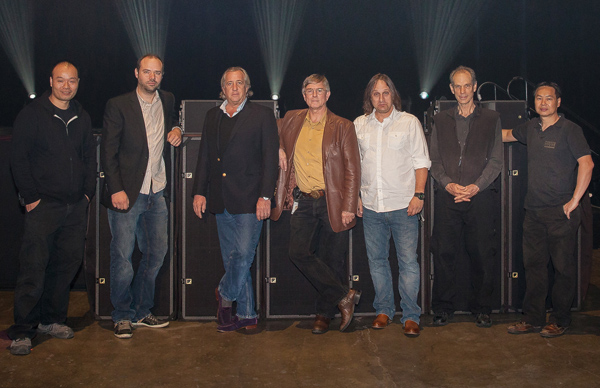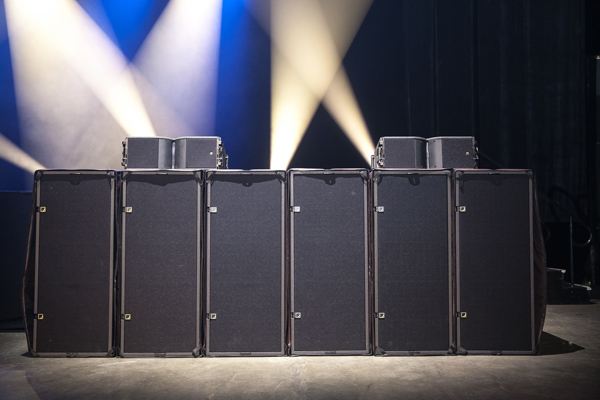
Key Factors
Auslan headed up the project, with colleagues Robert Carvell (production department supervisor) and Roy Clark (chief of audio) also integral to the process.
The team began discussions with L-Acoustics, initially focused on implementing K1 arrays before shifting to the more compact K2 that better fit the room and application. A benefit of the L-Acoustics platform is that it’s a staple of major touring artist riders.
“Rider friendliness and support, how easy it is to get replacement parts, how robust it is – we thought about all of those things and L-Acoustics came up with high marks,” Auslan notes. There was a fair amount of interviewing other engineers about the K2, Clark adds.
However, several major brands offerings were evaluated for sound quality, price point and post-purchase support. Another key factor in the team’s decision-making process was the ability to ‘steer’ output, to direct it where it needed to be with a high degree of accuracy. “Once we factored in all of those things, the K2 emerged as the all-out winner,” Auslan says.
The K2 incorporates a combination of proprietary Panflex horizontal steering technology and Wavefront Sculpture Technology (WST) to heighten steerability, particularly important in being able to avoiding too much output reflecting off the ballroom’s large proscenium arch.

That proscenium definitely presents a challenge, notes Scott Sugden, L-Acoustics U.S. head of application, touring, who contributed design support on the project, utilizing proprietary SOUNDVISION 3D simulation software to help. “We spent a significant amount of time evaluating the design,” he says. “It’s a challenging space because it’s a modified theatre that they’ve essentially made larger by encompassing a certain amount of the stage space as audio space.
“The proscenium, however, is in the same place it was 60 years ago, and the PA is 40 to 50 feet upstage of that, so you’re shooting through a narrow window to hit the rest of the audience,” he continues. “The other difficulty is that the stage isn’t permanent. There are multiple formats for it so the PA had to be modifiable depending on the type of show they’re doing.”
The ability to differentially control the horizontal coverage for different parts of the array with the same box and consequently avoid the proscenium – to narrow the directivity of the boxes in a symmetrical and asymmetrical format – was integral to achieving optimized coverage.
“As the audience gets closer and we gain proximity, we’re able to make the PA wider on the onstage side, but not the offstage side, and can prevent energy from hitting this giant brick wall,” Sugden explains. “Generally speaking in a theatre environment, one of the biggest challenges is vertical coverage. You need to get 50, 60, 70 degrees in vertical coverage and the K2 is able to do up to 10 degrees between enclosures, which is quite a lot for a system of this size.”
Simple Flexibility
The capacity of the ballroom varies, with two primary configurations available. Concerts with seating and standing room accommodate 3,500, while a diverse assortment of special events can be served with a flexible setup that can host up to 1,000. In addition, the venue’s 24-foot-deep “hard” stage suffices for most events, but it’s usually extended 16 more feet into the house for concerts. This results in two different positions for the main system’s left and right arrays, depending on the depth of the stage.
Moving the arrays, which are flown via CM motors with Motion Labs control, is relatively straightforward. “We change roughly one-third of the angles on the array, keep the rest the same and drop the rig using six motors to change position,” Clark notes. “I should also mention that the K2 does go down to 35 Hz and therefore has the ability to throw deep lows to the back of the room, which is helpful. So when guests walk in they hear amazing low end right away.”
The K2 arrays are made up of 12 boxes per side. “With that configuration, there’s the ability to set the horizontal dispersion differentially,” explains Chris Sullivan, application engineer, East Coast for L-Acoustics, who performed the system calibration in August. “The top three boxes are set to 70 degrees, which is the narrowest dispersion for the top two balconies. The bottom nine we actually go into asymmetrical output and are doing 90 degrees asymmetrical dispersion onstage. So that’s 35 degrees offstage and 55 degrees onstage, which is advantageous in avoiding the proscenium.

